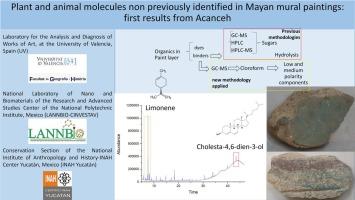以前未在玛雅壁画中发现的植物和动物分子:阿坎切的第一批结果
IF 1.5
2区 历史学
0 ARCHAEOLOGY
引用次数: 0
摘要
自从玛雅绘画技术被发现以来,关于它的争论一直很广泛。最初,由于它们与庞培壁画相似,这些壁画被错误地称为“玛雅壁画”。然而,应用于前西班牙玛雅壁画知识的考古测量学研究经常发现有机粘合剂,这表明玛雅画家在他们的发展中主要使用干燥技术。但是这些艺术家使用了什么有机粘合剂来达到这个目的呢?经过几十年的优化物理化学方案来检测它们,结果仅对少数植物基粘合剂具有结论性。以前的分析方法适用于其他作者(Magaloni, 1998a, 2001;Vázquez de Ágredos Pascual, 2006;Guasch-Ferre, 2016;guasch - ferr本文章由计算机程序翻译,如有差异,请以英文原文为准。

Plant and animal molecules non previously identified in Maya mural paintings: First results from Acanceh
The debate regarding the Maya painting technique has been extensive since its discovery. Initially, due to their similarity to the Pompeian frescoes, these paintings were mistakenly referred to as “Maya fresco wall paintings”. However, archaeometry studies applied to the knowledge of pre-Hispanic Maya murals have frequently detected organic binders, which indicates that Maya painters mainly applied dry techniques in their development. But what organic binders did these artists use for this purpose? After many decades of optimizing physicochemical protocols to detect them, the results are only conclusive for a few plant-based binders. Previous analytical methods applied for other authors (Magaloni, 1998a, 2001; Vázquez de Ágredos Pascual, 2006; Guasch-Ferré, 2016; Guasch-Ferré et al., 2019) have ranged from stratigraphic observation using optical microscopy to more advanced techniques focusing mainly on plant-derived sugars. This article describes the results obtained by applying a methodology for the extraction of medium polarity organic components using Gas Chromatography-Mass Spectrometry (GC–MS) to Maya mural paintings. This methodology has identified new molecules suggesting plant and animal origin in mural paintings remains from Acanceh, dating from the Late Classis Period (ca. 600–900). These results not only provide new evidence on pictorial binders, but also invite replication of this study on other murals from the Maya area to expand our knowledge of painting technique of these works, which are of great interest to archaeology, art history, conservation and restoration sciences.
求助全文
通过发布文献求助,成功后即可免费获取论文全文。
去求助
来源期刊

Journal of Archaeological Science-Reports
ARCHAEOLOGY-
CiteScore
3.10
自引率
12.50%
发文量
405
期刊介绍:
Journal of Archaeological Science: Reports is aimed at archaeologists and scientists engaged with the application of scientific techniques and methodologies to all areas of archaeology. The journal focuses on the results of the application of scientific methods to archaeological problems and debates. It will provide a forum for reviews and scientific debate of issues in scientific archaeology and their impact in the wider subject. Journal of Archaeological Science: Reports will publish papers of excellent archaeological science, with regional or wider interest. This will include case studies, reviews and short papers where an established scientific technique sheds light on archaeological questions and debates.
 求助内容:
求助内容: 应助结果提醒方式:
应助结果提醒方式:


